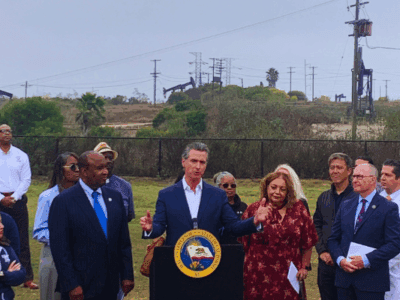California Supreme Court decides in favor of accurate environmental impact analysis (and cleaner air)
The California Supreme Court just issued an important decision interpreting public agencies’ obligations under the California Environmental Quality Act. This case will result in cleaner air in southern California. It also establishes that public agencies must measure environmental impacts from a new project against actual existing conditions, rather than against theoretical conditions (based on permits granted for other projects) that would tend to understate the impacts of the new project.
[Disclosures: Co-blogger Rick Frank argued this case in the Supreme Court for the petitioners (congratulations, Rick!). And UCLA’s Frank G. Wells Environmental Law Clinic, under my direction, represented several amici supporting the petitioners, including Sierra Club, the Natural Resources Defense Council, Endangered Habitats League, and the Planning and Conservation League.]
In this case, Communities for a Better Environment v. South Coast Air Quality Management District, an industrial facility possesses a permit allowing its equipment to emit pollutants at a level much higher than has actually been reached in the facility’s actual operation. The facility, the massive ConocoPhillips petroleum refinery in the Los Angeles neighborhood of Wilmington, directly abuts a neighborhood that has long endured localized environmental impacts from the refinery’s operations. A proposed new project (involving production of a new type of fuel through a new industrial process) would increase emissions significantly over the historical levels of emissions from the same equipment, but would still be within the previously-permitted levels. This project would add several hundred pounds of oxides of nitrogen (NOx) per day to the air, as compared to the factory’s current and historical air pollution emissions. This amount exceeds the South Coast Air Quality Management District’s significance threshold of 55 pounds per day (meaning that ordinarily, any new project that may result in more than 55 new pounds of NOx emissions would require preparation of an Environmental Impact Report, and the facility would have to implement all feasible mitigation to reduce the NOx emissions impacts).
ConocoPhillips and the District had argued that because the facility’s equipment was already permitted to emit more than the additional amount from the new project, the projected new emissions could not create a significant environmental impact over existing conditions. But the petitioners argued that CEQA requires that the significance of new emissions from a new project be evaluated against existing conditions, not against theoretical conditions allowable under a different permit.
The court decided that the baseline for impacts analysis under CEQA should be calculated based on actual emissions, not on the theoretical emissions allowed under the old permit. Because the facility’s current industrial processes never did and never would operate at anywhere near the permitted level of emissions, and because this new industrial process is legally and conceptually a new “project,” the Court agreed that the District must evaluate the impacts of the new process against actual emissions, and required the District to develop a full Environmental Impact Report for the project.
As a result of yesterday’s unanimous decision, the regulatory agency that approved the new project – the South Coast Air Quality Management District – has to do a full Environmental Impact Report because there’s a fair argument that the new project may cause a significant negative impact on air quality. Under CEQA, that EIR will have to describe, and the project will have to incorporate, all feasible mitigation for the significant air quality impacts that will result from the project. The result will be cleaner air for Wilmington and for our already-polluted air basin in Los Angeles. This case will also have implications for other situations in which a project proponent might attempt to rely on entitlements from a previously-permitted project in order to justify decreased environmental review of a new project.
Here is an excerpt from the opinion’s introduction (with citations and footnotes omitted):
The California Environmental Quality Act (CEQA) requires a public agency to prepare an environmental impact report (EIR) only on projects that may have significant environmental effects. To decide whether a given project’s environmental effects are likely to be significant, the agency must use some measure of the environment’s state absent the project, a measure sometimes referred to as the “baseline” for environmental analysis. According to an administrative guideline for CEQA’s application, the baseline “normally” consists of “the physical environmental conditions in the vicinity of the project, as they exist at the time . . . environmental analysis is commenced . . . .”
In the present case, ConocoPhillips Company (ConocoPhillips), the private proponent of a project to conduct a new industrial process at a petroleum refinery, and the South Coast Air Quality Management District (District), whose failure to prepare an EIR before approving the refinery project is at issue, contend that the existence of valid permits to operate industrial equipment used in the project at particular levels establishes an exception to the general rule that existing physical conditions serve as the baseline for measuring a project’s environmental effects. Instead, they maintain, the analytical baseline for a project employing existing equipment should be the maximum permitted operating capacity of the equipment, even if the equipment is operating below those levels at the time the environmental analysis is begun. Failure to use the maximum permitted operations as a baseline, they argue, would contravene CEQA’s statute of limitations and deprive the permit holder of its vested rights.
We conclude neither the statute of limitations, nor principles of vested rights, nor the CEQA case law on which ConocoPhillips and the District rely justifies employing as an analytical baseline for a new project the maximum capacity allowed under prior equipment permits, rather than the physical conditions actually existing at the time of analysis. The District therefore abused its discretion in determining the project at issue would have no significant environmental effects compared to a baseline of maximum permitted capacity.







Reader Comments